Value Midrange Common Components
While AMD and Intel architectures differ in sockets and sometimes memory configurations, more is the same in the two systems than different. For that reason the Intel and AMD value midrange systems share a number of common components.
 |
For video card best value we have paired the PowerColor AX4850 Radeon HD 4850 512MB with both the Intel and AMD systems. Our recent Video Card Buyer's Guide recommended the 4850 512MB as the best value in the $130 to $150 price range. With many vendors now offering rebates that yield a final price of $120, the 4850 is an excellent value. Architecturally the 4850 and 4870 are the same card, with the 4870 clocked higher. At lower resolutions the 4850 and 4870 perform about the same, making the 4850 a great match to our value midrange system, where price is a large concern. You will certainly be happy with the gaming capabilities of the 4850, especially when you consider bang-for-the-buck.
On the Intel system, the Gigabyte GA-EP45-UD3P motherboard provides a second PCI x16 slot. Video performance can be improved even further by adding a second Radeon HD 4850 512MB in CrossFire mode. You can also start with the 4850X2, which combines two 4850s in a single slot for about $260. This is actually a bit higher than just buying two 4850 cards for CrossFire, but there are board real estate savings with both cards on a board in a single slot. You could also upgrade to the 4870 1GB for more power at higher resolutions with "eye candy" turned on. The 4870 1GB upgrade adds about $40, and the added memory can be useful for resolutions of 1920x1080 or higher. The motherboard choice for AMD is the Biostar TForce TA790GX3 A2+, which also provides multiple x16 slots for CrossFire, so the same video options apply to the AMD value system.
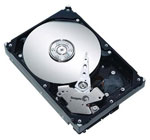 |
1TB hard drives are now a routine hard drive capacity. The 1TB drives are large, fast, and stable, so it was easy to recommend the Seagate Barracuda 1TB drive (1000GB) at $90. While the Seagate 1.5TB and early 1TB Seagate drive were plagued with problems upon release, the performance and reliability of this 1TB Seagate model has been excellent in our testing so far. For the price of around $90 the value is incredible. While there are differences between hard drives, outside of running benchmarks most people aren't likely to notice the difference in performance between Western Digital, Seagate, Samsung, Hitachi and other major brands. All are worthy of consideration if the price per gigabyte (or terabyte) is right.
 |
We wanted the optical drive for our value system to have the ability to play Blu-ray disks. The flexible LG GGC-H20LK has the ability to read both Blu-ray and HD-DVD format disks. It also can burn DVDs at 16x speed in single or dual-layer formats. It cannot, however, burn 25GB/50GB Blu-ray disks. Adding the ability to burn BDs increases the cost to around $200 to $250. BD burners like the $200 LITE-ON SATA burner or the $230 LG GGW-H20LK 6X Blu-ray burner are good alternatives.
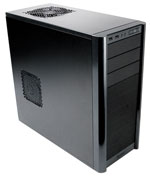 |
Cases are often very personal choices when it comes to features, and you may already have a favorite. If you don't you should look at the recommended Antec Three Hundred. The Three Hundred is a bottom-mount power supply design. Some love this configuration, others hate it, but it works well in the Three Hundred. It is definitely reasonable at the current $55 cost, but that does not mean it is a "cheap" case. It comes standard with a 120mm rear exhaust fan and a 140mm top fan, which both feature a 3-speed switch. There is also room to mount two additional front 120mm fans behind a washable dust filter, so you can effectively cool anything from a single hard drive to a large RAID array. Inside are a total of nine drive bays - six internal 3.5" drive bays and three 5.25" external. Front USB, headphone, and microphone jacks are also standard, and they are conveniently located at the top of the front panel. That makes them usable in the common "on the floor" setup. If you prefer a more traditional case configuration the Cooler Master Mystique, selling for $80, mounts the PSU on top, provides font panel jacks, and is also loaded with expansion ports and two 120mm fans.
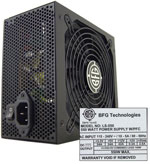 |
The power supply for the value midrange systems is the winner of the recent 500W to 550W PSU roundup. The BFG Tech LS-550 grabbed our Gold Editors' Choice in the roundup for its great balance of performance and value. The BFG delivered good performance in every aspect, with tight voltage regulation and ripple well within specifications. Efficiency was through the roof, with 86% efficiency at 20% load. It also generated the highest maximum efficiency of 88% on 230VAC and 86% on 120VAC. With a good selection of connectors and reasonable cable lengths, the LS-550 is a great PSU for a value-oriented midrange system.
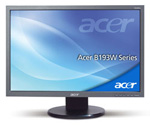 |
The last major component to discuss is the display, and here the tilt was toward best value at full 1080p HD (1920x1080) resolution. In our last guide we chose a "new class" of 16:9 21.5" LCD monitors that provide true 1080p resolution at the then break-through price of just $199. Three months later we can choose a larger Acer 23" (nominal 24") monitor for even less at $190. With the 21.5" now $180 and the same resolution available as a 23" for just $10 more the larger monitor is the better value. It is also worth mentioning that the Acer 23" is one of the few monitors in its class that comes with all three video cables. Yes, an HDMI cable is included in the Acer box.
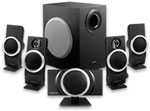 |
The Logitech X-540 has been a perennial favorite of users as a reasonably priced, good-performing, powered 5.1 computer speaker system. At $80 it will certainly not challenge the performance of a separate Dolby amplifier powering audiophile speakers, but it will provide surprisingly good sound for the price. The Creative Inspire T6100 76W 5.1 Speaker system is a similar powered speaker system that is selling at about the same price as the X-540. The Creative speaker system is our choice in the AMD value midrange system, but either speaker system is a good choice for these value midrange builds.
These are clearly desktop systems, so the keyboard and optical mouse are the basic Microsoft OEM kit. If you have more specific needs or a favorite gaming mouse you likely know more exactly what you prefer. The Microsoft pair is very capable for most. For greatest compatibility we have chosen Microsoft Vista Home Premium OEM as the operating system. Unless you have specific networking and special enterprise security needs there is no real reason to pay extra for Vista Ultimate. One thing to note is that if you buy a full retail Ultimate DVD, you can get a discounted price on a second copy of Vista. We have selected the OEM "single install" version of Vista, in order to reduce costs.










73 Comments
View All Comments
RadnorHarkonnen - Wednesday, April 8, 2009 - link
Don't be Pedantic. Chill Out mates.I have a X2 4800+ OCed to 3Ghz. I game on it, i have a small file server on it, an exchange server always rolling, I GIMP some fotos, use sum torrentz, test like things i have fun with on my VMware, the wife is always seeing a movie of some sort (Desperate housewives or sex in the city, or some crap like that) plugged via HDMI to my TV. And much more...
A bit of this, a bit of that.
I personally like his rig. I wouldn't buy one like his, but hey there are other priorities. Maybe in the summer ill buy another for crossfire.
Wineohe - Tuesday, April 7, 2009 - link
Hmm. Not sure I get 1TB Barracuda. Sometimes price isn't everything. I guess you gotta spread the love.Wesley Fink - Wednesday, April 8, 2009 - link
The Seagate is now quite reliable and fast. The speed is a true 7200rpm, and not a "green" 5200rpm. Cache is 32MB, and not 16MB like many competing drives.Warranty is reduced to 3 years from the previous 5 years, but warranty service and replacement is very easy directly with Seagate. Seagate still offers the Enterprise version of this drive with 5-year warranty for $140, but if truth be know it is the same drive with a longer warranty and a higher price to pay for the longer coverage.
You can pay more for the same features and specifications. As we have said many times, you are generally safe with an HD from the major players and you can shop on price as long as specs are the same. There are good WD choices as well.
MadMan007 - Wednesday, April 8, 2009 - link
Seriously? Did you just say it's a great drive based upon paper specs? Features and specifications do not equal real world performance. Seagate drives after the 7200.10s should not be recommended. Supposed reliability issue aside the firmware is heavily slanted toward reads and the drives perform middle of the pack overall when looking at a wide range of real world uses. I understand for an article like this there's a need to stick to a strict price point but anyone who wants a 7200RPM 1TB drive ought to look elsewhere (WD drives are great atm) or if they don't need the space they'd be better served by a 7200RPM 640GB WD drive.Wesley Fink - Wednesday, April 8, 2009 - link
We use both the recent Seagate and WD 1TB drives. Both have performed well in the labs.MadMan007 - Wednesday, April 8, 2009 - link
Then you aren't testing them well enough but that's ok I've never read Anandtech for HD reviews. Heck the last non-SSD review is almost a year old and that was the V-Raptor, before that there is a 1TB drive review which is thoroughly outdated. Obviously in fairlyland everyone has only SSDs by now, the SSD articles are intriguing but don't reflect what people actually buy for storage as your own guides show.MadMan007 - Wednesday, April 8, 2009 - link
Sorry the above reads more rantishly than I meant it. Anyway my point was that quoting a bunch of paper specs doesn't mean much.erple2 - Friday, April 10, 2009 - link
Some thing that seems to get lost a lot is the question for the normal user:"How much faster is this drive in the stuff I care about?"
Benchmarks are good, I suppose, but they're also ridiculously non-linear. a two fold increase in sequential read performance in HD Tach doesn't translate into a two fold reduction in windows boot up time (or application startup time).
Maybe they are linear, but only with extenuating circumstances - If I have an old drive that loads application X in 20 seconds, getting a more recent drive could reduce the load time by 2 seconds. Getting a drive that's "twice" as fast as the slower new drive may reduce the application loading time by twice the increase, not half the time - the app now loads in 16 seconds rather than 18 seconds.
I dunno. It seems that the more I look at "real world" scenarios (which I understand are very hard to quantify and benchmark - they're essentially wall clock timings), the difference between 2 drives of the same rotational speed are marginal. Heck, even the difference between a 7200RPM drive and a 10k drive seems awfully marginal.
How often do I copy a single huge (on the order of 1 gigabyte) file that's stored sequentially? I dunno. Most of my data is lots of files that are smaller than 10 MiB (music and pictures), with significant numbers that are in the < 1 MiB range (everything else that isn't MP3's or pictures).
Huh.. Now I sound like I'm ranting.
However, if Anandtech is using the drives all the time in their test systems (and they haven't failed), then I'd believe that they're at least reliable. They may not be faster than a couple of Raptors in Raid 0, but from what else I've read, that's a total waste of time and money for my usage patterns (which don't include running a heavily used database, or other server application).
marc1000 - Tuesday, April 7, 2009 - link
wow, while I read the article I lost the 1st comment spot.. hehewell, I read a lot of these guides here at AT, and should shay the components choices are generally good. too bad I live in a country other than USA or England, so I can never buy those parts with the "real" pricing, instead I always pay higher for newer parts... it's a joke for us.......
anyway, I would like to say to anyone interested that these new CPUs and GPUs are really terrific performers. Today I have a fairly simple Core2Duo e7200 (2.6ghz 3mb cache) paired with a Radeon HD3850 and 4GB RAM. I never could completely stress this simple system... even gaming, I can run almost all games at a very good quality (22" LCD monitor with 16x10res), except for CRYSIS of course (but I don't like it anyway).
ssj4Gogeta - Wednesday, April 8, 2009 - link
"too bad I live in a country other than USA or England, so I can never buy those parts with the "real" pricing, instead I always pay higher for newer parts"same here. :( Especially when a new graphics card is launched. The price is as high as 2x the price in the US.